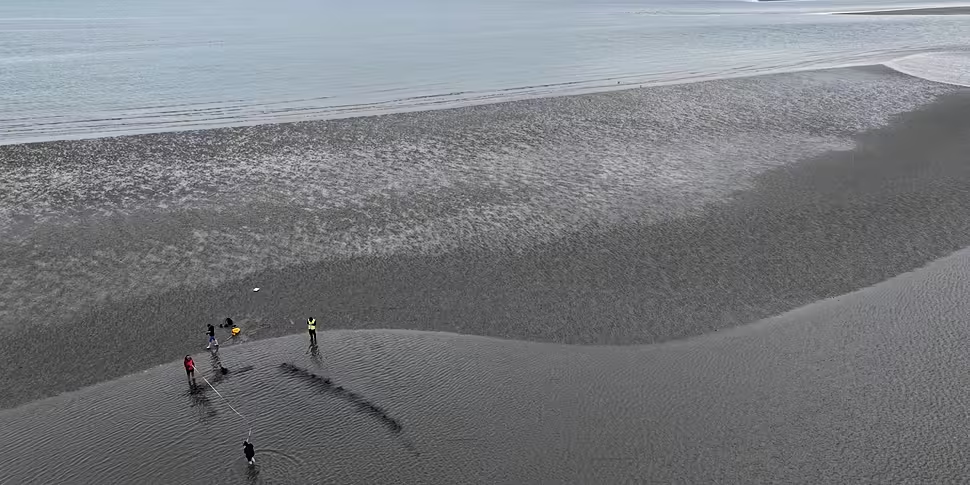Archaeologists are examining three shipwrecks which have washed up on a Dublin beach.
The remains of the unknown vessels at Portmarnock Strand are believed to date back as far as the 19th century.
They were discovered while a team from the National Monuments Service were trying to find another, known shipwreck nearby back in July.
Minister Darragh O'Brien today visited with underwater specialist archaeologists from the National Monuments Service (NMS) as they assessed newly-revealed shipwrecks on the Portmarnock Strand in north County Dublin.
Shifting Sand
Acting on a report from Nigel Motyer – a local underwater photographer and drone operator who captured aerial images of a wreck after it had become exposed due to a shifting sandbank – an NMS inspection was carried out and subsequent research determined that this vessel, possibly the remains of a 19th century fishing trawler, is recorded in the Wreck Inventory of Ireland, and was last visible in 2017 (and previously in the 1990s).
However, during its investigation, the team also discovered three previously undocumented wrecks. The wrecks, which are in the process of being fully identified, appear to date from as far back as the 19th century (see editors notes for more details).
Minister for Housing, Local Government and Heritage, Darragh O’Brien TD says: "This is a very exciting development. No doubt each of these shipwrecks has an important story to tell and we hope that, in time, we will learn more about them and the roles they have played in shaping our history.
"With a long-standing maritime legacy to celebrate and record, the important work of the National Monuments Service protects and preserves our underwater heritage, as evidenced by the 18,000 sites recorded in the Wreck Inventory of Ireland Database.
Inspection
Karl Brady, Senior Archaeologist with NMS who led the inspection explains: "Prolonged periods of wind from a particular direction move beach sands constantly and, in this case, had temporarily stripped the southern end of the beach of sand leading to the exposure of these wrecks.
"The NMS team has surveyed and photographed the wrecks, and ongoing analysis of the materials (for example, timber vs. metal), size, and construction style will help find answers as to the identity of the wrecks.
"The newly-discovered wrecks are poorly-preserved due to continuous tidal and storm action over the years. In general, while only the lower portions of the hulls and bow areas has survived, our team has identified timber frames, planking, metal knees, and even a metal winch/windlass system at the bow of one of the boats..
"Some 50 wrecks are recorded for the Portmarnock/Baldoyle area in the Wreck Inventory, identified through years of painstaking historical and archival research by the NMS. These range from 14th century trading ships to 20th century coal-boats. The physical remains of at least 13 of these vessels have been located.
"18th and 19th century newspaper articles and specialist maritime sources can shed some light on the wrecks, where they were built, and the identities of the crew. In some cases, records exist detailing the final moments of the vessels, as well as rescue attempts undertaken by local lifeboat crews, often in severe weather.
"Many vessels have similar construction style over the centuries, and there are often no dateable artefacts recovered, so confirming the identity of the wrecks and aligning them with historical records is challenging."
"Research by NMS indicates that most of the vessels recorded off Portmarnock Strand were lost during bad or stormy weather.
"Several of the ships, en route to Dublin, may have attempted to seek refuge in Howth Harbour during stormy conditions but failed to reach the safety of the harbour entrance and were compelled to run ashore on the strand, a desperate measure to save lives. Other ships, originating from ports on the west coast of Britain and bound for various global destinations, seem to have been unfortunate victims of stormy weather, driven ashore at Portmarnock, often at night. There is an unusually high number of wrecks in this location.
"The cyclical nature of sand movement on beaches often leads to the temporary exposure and subsequent reburial of shipwrecks, as seen here at Portmarnock.
"While partially uncovered at present, the wrecks appear stable and will most likely cover over in the coming weeks and months. This will help safeguard them from further deterioration and degradation, with the sediments acting as a buffer. Further monitoring of the wrecks and regular inspection of the beach by NMS, will ensure that the wrecks are further examined as and when uncovered, allowing for their full assessment over time, assisting in confirming their identity."













